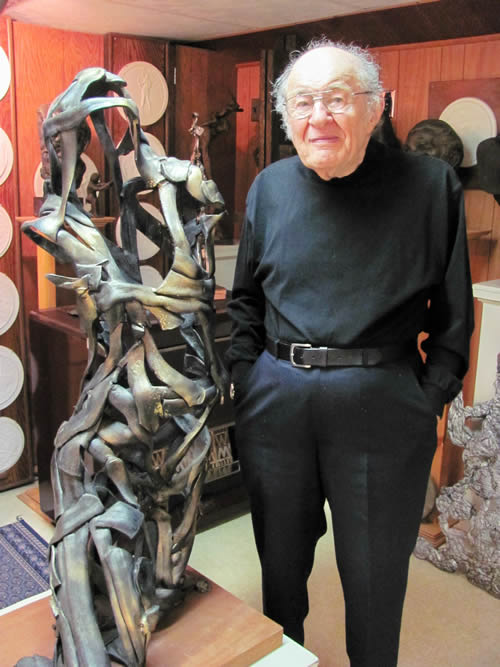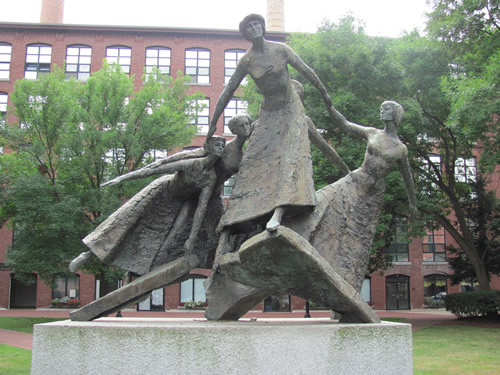
 Sculpture News at SculptSite.com
Sculpture News at SculptSite.com
Whistler House Museum of Art to Honor Sculptor Mico Kaufman with The James McNeil Whistler Distinguished Artist Award |
LOWELL, MA. - This fall, the Whistler House Museum of Art will honor the internationally acclaimed sculptor and medalist Mico Kaufman with the James McNeill Whistler Distinguished Artist Award and will premiere a special exhibition of his award winning works. The event and exhibition, Mico Kaufman: From the Miniscule to the Monumental, will present medallic portraitures, sculptures in bronze and plastic and works of art on paper and canvas and will take place at the UMass Lowell Inn and Conference Center on Sunday, October 17, starting at 4:00 p.m. with a celebratory award banquet beginning at 6:00 p.m. The award recognizes the contributions, achievements and talent of an artist who has consistently demonstrated the highest level of excellence in his work; promoting, enhancing and educating, while advancing the world of art for the citizens of today and tomorrow. "Mico Kaufman is a deserving recipient of this award. His talent is undeniable and his range is diverse...having mastered many mediums and styles, from the classical and traditional to the abstract and modern," said Sara Bogosian, president of the Whistler House Museum of Art, who is also co-chairing the event with Terry O'Connor. The exhibition is significant in that it will be the first full-scale survey of Kaufman's lifetime of work and traces his progression as an artist, featuring many of his significant works of art and recognition of his numismatic art (medals). "The occasion will introduce Mico's work to a new generation of viewers, and for the artist's longtime admirers will celebrate his importance within the history of art in the community and the world," said Bogosian. Mico Kaufman was born on January 3, 1924 in Buzeu, Romania, where he grew up with his parents, Adele and Herman Kaufman and two siblings, sister Liza and brother Ionel. A self-taught artist, he learned to draw and sculpt through experimentation with different mediums. At the age of 16, he created his first formal project, a nude female figure whittled from his uncle's broken cane. His mother's dream was that Kaufman become a concert violinist to follow in the footsteps of his famous cousin, violinist Louis Kaufman, but sculpting was Kaufman's first love. As he prepared for a career in the arts, World War II interrupted his studies, preventing him from finishing high school. With the escalation of the Anti-Semitic movement throughout Europe and the persecution of Jews in Romania, Kaufman eventually found himself spending three years digging trenches in a Nazi concentration camp, until his release at the age of 21. In 1947, at the end of the war, he left Romania for Italy where he began his formal art training in sculpture at the Academy of Fine Arts in Rome. When asked by school officials why he thought he could sculpt, he showed them the nude female figure he had whittled years before, and so he was admitted. The professors thought he was extremely talented so they presented him with a full academic scholarship to study at the prestigious institution. He later transferred to the Academy of Fine Arts in Florence to continue his studies. On his return to Rome, he met Katia Sanidas, a refugee from Greece. Soon after, they were married and in 1949 Katia gave birth to their first child, a daughter named Adele. In 1951, he received confirmation on his papers to legally leave Italy. At the age of 27, Kaufman immigrated to America with his wife and daughter, settling in Boston, Massachusetts. There they had two sons, named Arthur and Emil. In 1956, Kaufman became a United States citizen. Supporting a family made it difficult for Mico to work as an artist so he would occasionally deviate from his artistic path and do any job that would make ends meet. Eventually he found work at the Greater American Plastics Company in Nashua, New Hampshire designing figures out of clay to create plastic molds for the production of toys. In 1965, Kaufman received his first commission as a designer. He was asked to redesign the Simple Simon logo for the restaurant chain of Howard Johnson. That commission encouraged him to devote all of his time to improving his craft. Eventually he worked for several professional sculpture studios in Boston before opening his own studio in Tewksbury, Massachusetts. During the late 1960's and 1970's there was an enormous demand for numismatic medals. This is when Kaufman's career began to take flight, winning many important commissions. One of his first commissions was with the United States Government for the celebration of the 1976 Bicentennial. He created 192 different medals depicting important events in U.S. history. That high-profile commission gained him recognition in numismatic circles. As he continued his work in medallic portraiture, Kaufman distinguished himself notably for his official presidential medals of U.S. presidents Jimmy Carter, Ronald Reagan, George Bush and Gerald Ford. He is the only sculptor in American numismatics to have been commissioned for four official presidential medals. Unlike the profiles that had traditionally adorned such medals, he is credited for not only introducing the innovative interpretation of three-quarter and full-face portraits, but also with capturing a human quality and personality in the otherwise formal poses. Furthermore, his collection of almost 500 medals includes portraitures of Albert Einstein, Thomas Edison, Will Rogers, Michael Jackson, Arnold Palmer, Henry Kissinger and Elvis Presley. He has sculpted a series of medals for the Israeli government and created monetary coins for the Marshall Islands. In 1992 he became the recipient of the prestigious J. Sanford Saltus Award for Signal Achievement from the American Numismatic Society. In addition to his medal works, Mico Kaufman created numerous portraits in bronze of national and international figures, including Dwight D. Eisenhower, Arthur Fiedler, Dr. An Wang and Senator Paul Tsongas. A large number of these sculptures were actually created from live modeling sessions with these famous figures in U.S. business, history and the arts. Many of his medallic works and portraits can now be found in museums, including the Smithsonian Institution, British Museum, Brandeis University, American Numismatic Society and private collections all over the world. He has exhibited in many locations, including Boston, New York, Florence, London, Lisbon, Portugal, Helsinki, Budapest, Krakow, Colorado Springs and Lowell, Massachusetts. On a much larger scale, Kaufman's 17 outdoor sculptures and monuments include a seven-foot statue of artist James McNeill Whistler for the Whistler House Museum of Art; a bronze statue of Claude Debussy, which appears at both the University of Massachusetts Lowell and at St. Germain-en-Laye, France, birthplace of the famed composer; a five-figure sculpture of mill girls in Lowell, Massachusetts titled HOMAGE TO WOMEN; a sculpture called TOUCHING SOULS, of four children from different ethnic origins literally touching the soles of their feet as they sit spread-eagle in a circle in his hometown of Tewksbury, Massachusetts and outside of the Tewkesbury Abbey in its sister city of Tewkesbury, England. SPIRIT OF THE MARATHON, a monumental sculpture created to honor all marathon runners from Pheidippides, who first ran the distance from the town of Marathon to Athens in 490 B.C., and to all past and future winners. It is installed in Marathon Square, in Marathon Greece, near the start of the 2004 Olympic Marathon and the site of the Olympic rowing and canoeing events. The second identical sculpture appears at the one mile marker in Hopkinton, Massachusetts honoring the runners of the Boston Marathon. In recent years Kaufman has experimented extensively at the University of Massachusetts Lowell with abstract sculpture using extruded polyethylene. He is the first known artist creating works of abstract art in this medium and size. Different from his traditional bronze statues and medal portraitures, his work in molten plastic presents an artistic style that involves a freedom from all conventional design. It combines abstract fluid forms and favors a spontaneous and liberated personal style. James McNeill Whistler, for whom the award is named, was one of America's premiere19th Century Artist. He created and developed new techniques in painting and print making, which had a major impact on the art world. The recipient of the James McNeill Whistler Distinguished Artist Award follows in the footsteps of this inspiring artist. As Joseph Pennell, biographer of Whistler wrote in Life of Whistler, "His name and his fame will live forever." "Like Whistler, Mico Kaufman, the James McNeill Whistler Distinguished Artist Award recipient will also be remembered for his extraordinary contributions to the community and to the international world of art," said Michael Lally, executive director of the museum. The Whistler House Museum of Art, located in Lowell, Massachusetts, is the historic birthplace of the famous American artist, James McNeill Whistler. Established in 1878, as the Lowell Art Association Inc., it is the oldest incorporated art association in the United States. It is known internationally for its distinguished collection of 19th and early 20th century New England representational art. The Whistler House hosts many exhibits, lectures, educational programs, concerts and an array of social events. |
 Mico Kaufman extruded polyethylene sculpture |
 Mico Kaufman Homage to Women |
More Sculpture News ....
Submit your SCULPTURE NEWS.
It's easy, just send us an e-mail
(click on Submit News in the left menu) with your pertinent information along with images, we'll take care of the rest. Sculpture makes our world a much better place in so many ways!
SculptSite.com, along with Sculptors and their creative genius all helping to bring the beauty and message of Sculpture to a hurried world.

